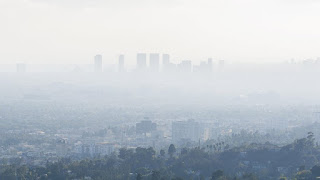Smog is the main key factor in the ever-growing concern for environmental health, understanding the nuances of air pollution, particularly smog, becomes crucial. This article aims to discuss the definition, effects, and causes of smog, shedding light on its role in exacerbating air pollution.
 |
| Smog |
Definition of Smog
Smog, a mixture of smoke and fog, refers to a visible haze that stays in the air. It comes in different forms, with photochemical and sulfurous smog being the most common. Photochemical smog results from the interaction of pollutants under sunlight, while sulfurous smog is linked to industrial emissions.
Photochemical Smog
Photochemical smog is a type of air pollution formed when sunlight reacts with pollutants emitted from vehicles, industrial processes, and other sources. This reaction produces a hazy mixture of harmful chemicals, including ground-level ozone and other secondary pollutants. Often observed in urban areas with high traffic, photochemical smog can have adverse effects on respiratory health and overall air quality. Efforts to reduce emissions from vehicles and industrial activities play a vital role in mitigating the formation of photochemical smog, contributing to cleaner and healthier air for communities.
Which type of pollution includes cfcs and smog?
Smog Test Near Me
Smog History
Effects of Smog on Health
The impact of smog on human health is profound. Short-term exposure can lead to respiratory issues, irritation, and exacerbation of pre-existing conditions. Long-term exposure is associated with chronic respiratory diseases and cardiovascular problems.
Causes of Air Pollution
Air pollution, of which smog is a significant contributor, arises from various sources. Vehicular emissions, industrial activities, and natural factors like wildfires collectively contribute to the degradation of air quality.
Smog Check History
Smog check history refers to the record of emissions tests conducted on vehicles to ensure they meet air quality standards. It's a crucial aspect of environmental protection, helping to reduce pollutants emitted by cars. The history includes details of when each smog check was performed, the results, and any necessary actions taken to address emissions issues. This information is valuable for both vehicle owners and authorities, ensuring that vehicles on the road are environmentally friendly and comply with air quality regulations.
Formation of Smog
Smog formation involves complex chemical processes. Pollutants such as nitrogen oxides and volatile organic compounds react in the presence of sunlight to create smog. Atmospheric conditions, including temperature inversions, play a crucial role in trapping smog in specific areas.
Urbanization and Smog
The rapid urbanization of cities has led to increased smog levels. Poor urban planning, reliance on fossil fuels, and high population density contribute to the concentration of pollutants that form smog.
Global Impact of Smog
Beyond local consequences, smog has far-reaching global implications. It contributes to climate change by releasing greenhouse gases, further emphasizing the need for concerted global efforts to address this issue.
Combating Smog: Environmental Policies
Existing environmental policies aimed at smog reduction need continual evaluation and improvement. Stricter regulations and their effective enforcement are crucial for mitigating smog.
Technological Innovations in Smog Reduction
In the quest for cleaner air, technological innovations play a pivotal role. Electric vehicles, advancements in industrial processes, and renewable energy sources all contribute to reducing smog levels.
Community Engagement in Smog Reduction
Communities can actively participate in smog reduction efforts. Simple actions, such as reducing vehicle emissions, supporting clean energy initiatives, and planting trees, collectively make a significant impact.
Educational Programs and Awareness
Education and awareness are key components in the fight against smog. Informing the public about the dangers of smog and providing actionable steps for reducing individual carbon footprints is essential.
Smog-Free Cities: Success Stories
Several cities have successfully tackled smog-related challenges. Copenhagen, Zurich, and Vancouver serve as examples of effective strategies and solutions that other urban areas can adopt.
Future Outlook
The vision for a smog-free future is attainable through collective efforts. Implementing sustainable practices, embracing green technologies, and fostering global collaboration can pave the way for cleaner air.
Conclusion
In conclusion, smog remains a critical environmental challenge that demands attention and action. From defining its intricacies to exploring its global impact, addressing smog requires a multi-pronged approach. By combining effective policies, technological advancements, community engagement, and global collaboration, we can strive towards a world where the air we breathe is cleaner and healthier.
FAQs
How does smog contribute to climate change?
- Smog releases greenhouse gases that trap heat in the atmosphere, contributing to global warming.
Are there immediate health risks associated with smog exposure?
- Short-term exposure to smog can lead to respiratory issues, irritation, and exacerbation of pre-existing conditions.
Can individuals make a difference in reducing smog?
- Absolutely! Simple actions like reducing vehicle emissions, supporting clean energy, and planting trees can contribute to smog reduction.
Which cities have successfully reduced smog levels?
- Cities like Copenhagen, Zurich, and Vancouver have implemented effective strategies to combat smog and improve air quality.
How can I get involved in smog reduction initiatives?
- Stay informed, participate in community clean




